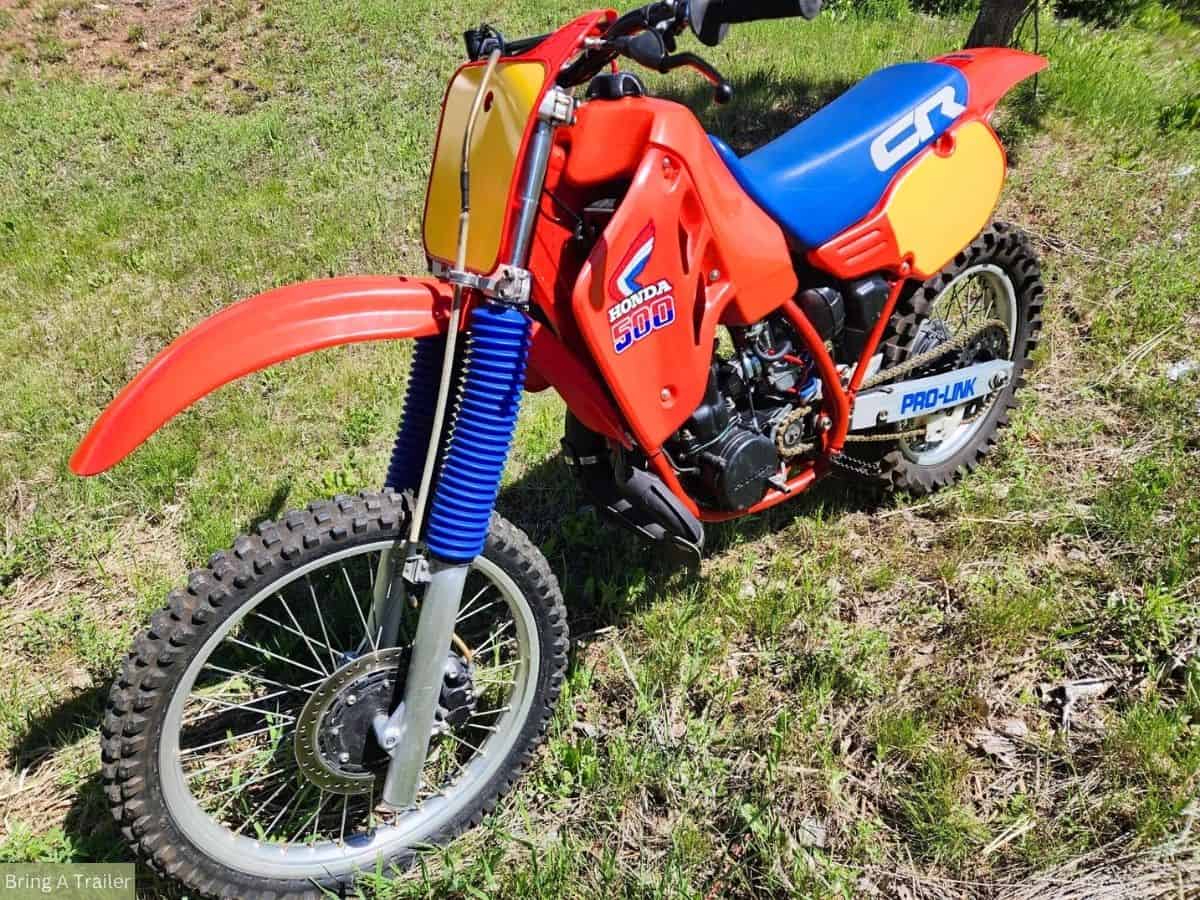The Honda CR500 is a legendary two-stroke dirt bike that was king of the motocross world for over a decade.
First introduced in 1984, the CR500 was Honda’s answer to the growing demand for high-performance, big-bore motocross bikes.
With its powerful 491cc two-stroke engine and advanced chassis, the CR500 quickly gained a reputation as a super-fast bike that could conquer any terrain.
In this in-depth guide, we’ll provide a complete overview of the Honda CR500, covering every aspect of the machine, from its specs to its evolution.
Plus, we’ll also answer some of the most common questions about the bike, including how much it costs, how much horsepower it has, and how fast it goes.
So whether you’re a seasoned rider, a collector, or simply a fan of dirt bikes, this guide will give you a thorough understanding of the Honda CR500 and why there continues to be such a high demand for the bike over 20 years later.
History & Evolution of the Honda CR500
First introduced in 1984 with an air-cooled engine, for most, 1985 was the first true year of production, as this is when Honda switched the bike to a liquid-cooled engine, which it kept throughout the rest of its life.
Regardless of what you consider the first year of production though, the Honda CR500 quickly made a name for itself as one of the most powerful and fastest 2-stroke dirt bikes available.
In fact, the first few years of the bike’s production in 85′ and 86′ particularly, were the most powerful and fastest versions of the bike, as the earliest iterations of the CR500 were capable of winning National AMA Motocross races out of the box.
Which was great for winning races but not so great for the average rider, as the earliest versions of the bike were so powerful that it felt like trying to tame a wild beast.
Because of this, Honda de-tuned the bike from then on with longer silencers and more restrictive porting, to try and tamp down some of the power.
Beyond just engine power though, as the years progressed, Honda continued to refine and improve the CR500, ensuring that it remained at the forefront of performance and technology.
First Generation: 1984 – 1988
The first generation of the CR500, produced from 1984 to 1988, laid the groundwork for the bike’s success.
During this period, Honda focused on fine-tuning the engine’s power delivery, optimizing the suspension settings, and enhancing the overall handling characteristics of the machine.
Second Generation: 1989 – 1992
The second generation of the CR500, introduced in 1989, brought about some significant changes and improvements.
As Honda engineers redesigned the engine head to smooth out the power band, which also indirectly helped to make kick-starting the bike easier, as there was less compression to deal with.
In addition, the bike also underwent some pretty big exhaust changes that made the system more like what you’d find today in a modern two-stroke.
Third Generation: 1993 – 2001
From 1993 to the end of its production in 2001, the Honda CR500 stayed pretty much the same except for the graphics package and slight tweaks to the overall look and design.
As the motocross and dirt bike world began to shift towards four-stroke engines in the late 1990s and early 2000s, the Honda CR500 remained a favorite among riders who appreciated the raw high-strung power and unfiltered ride that only a two-stroke machine can provide.
Despite the changing landscape of the sport, Honda continued to produce the CR500 until 2001, showcasing its popularity and the loyalty of its dedicated fan base.
Today, the Honda CR500 is remembered as a true icon of the motocross world, a machine that defined an era and left a huge mark on the sport.
Its legacy lives on through the countless riders who experienced the thrill of riding this legendary dirt bike, and through the enthusiasts who continue to celebrate its rich history and unmatched performance.
Honda CR500 Specs:
Honda CR500 Hot Lap (Taming the Beast!)
How Much Does a Honda CR500 Cost?
The Honda CR500 is a highly sought-after and iconic dirt bike, so you shouldn’t expect to pick one up cheaply unless the bike is completely trashed.
That being said, the cost of buying a CR500 can vary greatly depending on the year of manufacture, overall condition, and any modifications or upgrades made to the bike.
On average, a well-maintained Honda CR500 will usually cost anywhere from $5,000 to $10,000.
It’s worth noting though that exceptionally rare or well-preserved examples of the Honda CR500 can command even higher prices, especially those produced in the 1980’s.
How to Buy a Honda CR500
If you plan on trying to buy a Honda CR500, patience and persistence are key.
Given the bike’s popularity and the limited number of well-preserved examples left, it can often take considerable time to find the right CR500 at the right price.
However, consistently scouring online classifieds, attending vintage motocross events, and networking with other enthusiasts can speed up the process and help increase the chances of finding one.
Some of the best places I’ve seen to buy a used Honda CR500 include:
- Cycle Trader
- Ebay
- Facebook Market Place
- Bring a Trailer
- Mecum Auctions
- Iconic Motorbikes Auctions
- Craigslist
Before buying any Honda CR500 though it’s important to thoroughly inspect the bike and assess its overall condition.
As factors like the engine’s health, the presence of original components, and the quality of any aftermarket upgrades can significantly impact the value of the motorcycle.
It’s also crucial for you to ensure, to the best of your ability, that the bike has been properly maintained and serviced throughout its life, as the cost of rebuilding a neglected CR500 can be substantial.
What Were the Best Years for the Honda CR500?
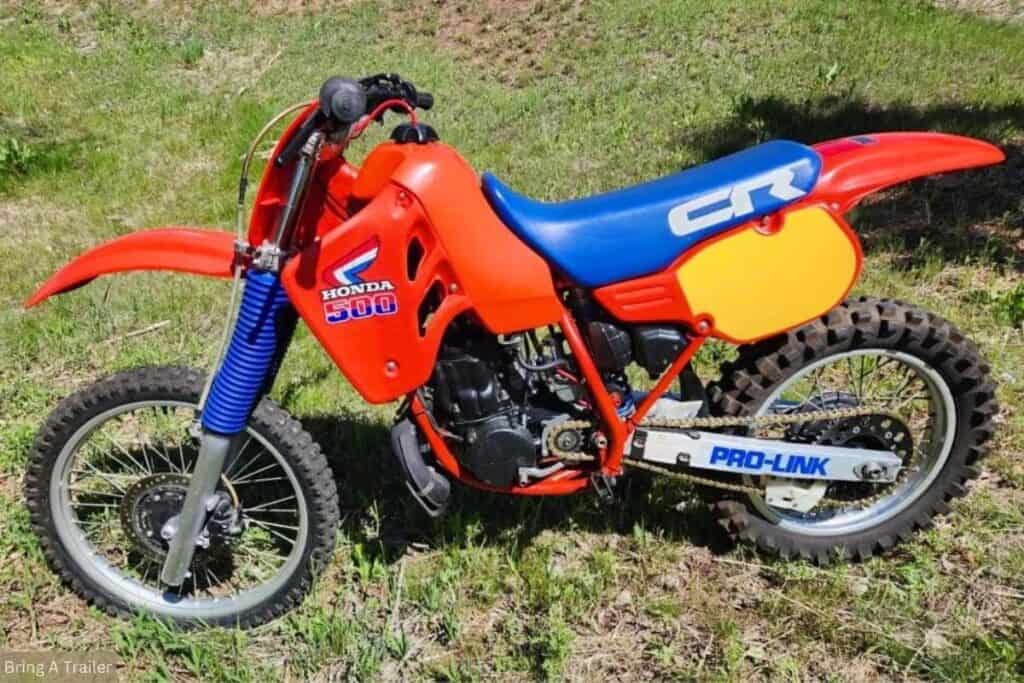
While the Honda CR500 enjoyed a long and successful production run from 1984 to 2001, many enthusiasts and experts agree that the early years of the bike’s production, particularly those in the 1980s, were some of the best.
These early models laid the foundation for the CR500’s legendary status and set the standard for big-bore two-stroke performance.
The 1984 Honda CR500 marked the beginning of an era, introducing riders to a powerful, well-balanced machine that was capable of conquering any motocross track.
The bike really found its stride though, in 1985 when Honda switched the bike’s engine to more efficient liquid cooling.
As Honda continued to refine the CR500 throughout the 1980s, the bike only got better.
Throughout the late 1980s, the Honda CR500 continued to dominate the motocross scene, thanks to its unrivaled power, exceptional handling, and rock-solid reliability.
While later model years saw significant improvements and advancements, many purists and collectors hold a special affinity for the CR500s of the 1980s, as these early examples, especially the 1985 and 1986 models, embodied the raw, unbridled spirit of the two-stroke era.
How Much HP Does a CR500 Have?
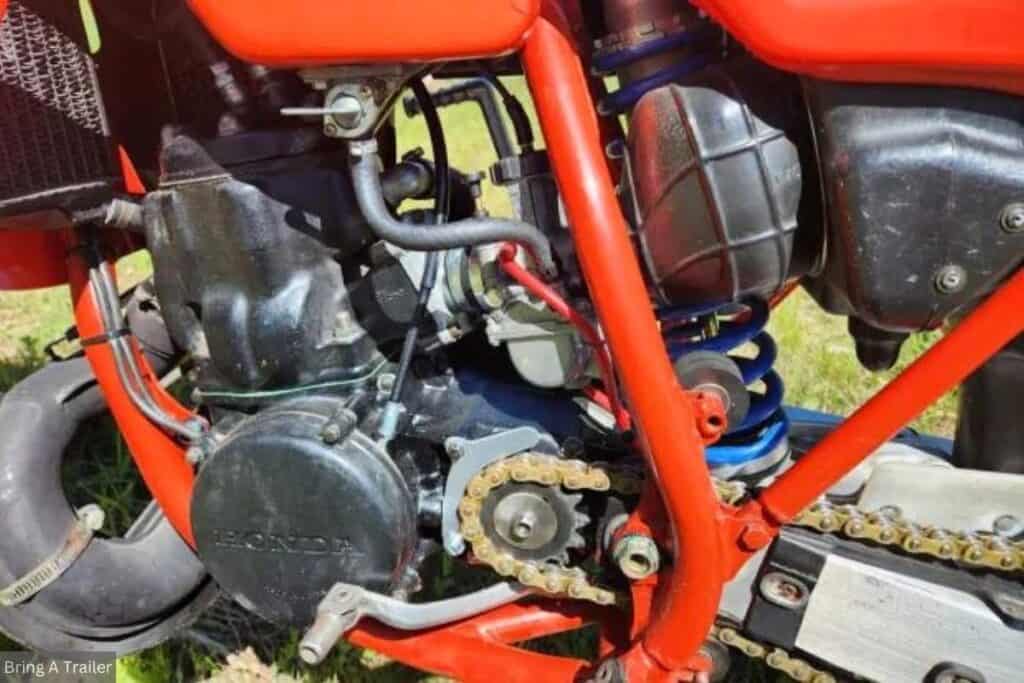
The incredible power output of the Honda CR500 set it apart from other dirt bikes in its class, earning it widespread fame.
Throughout its production run, however, the CR500’s horsepower figures varied slightly, depending on the model year.
In the first year of production (1984), the Honda CR500 had 59 HP, from 1985 to 1991 the bike had the most horsepower at 64.6 HP, before finally offering 56 HP in 1992, which it had for the rest of the production run.
While the Honda CR500’s horsepower figures were class-leading, all this horsepower meant this two-stroke dirt bike required a skilled rider to manage, as the CR500’s tendency to break traction under hard acceleration demanded disciplined throttle control.
That being said, one of the main reasons the Honda CR500 remains a legend even to this day is due to the raw horsepower the bike offers.
It’s important to note, however, that the CR500’s horsepower numbers, as is the case with all dirt bikes, are measured at the crank.
This means the power delivered to the rear wheel is slightly less due to power loss through the transmission and drive chain.
Why did Honda Stop Making the CR500?
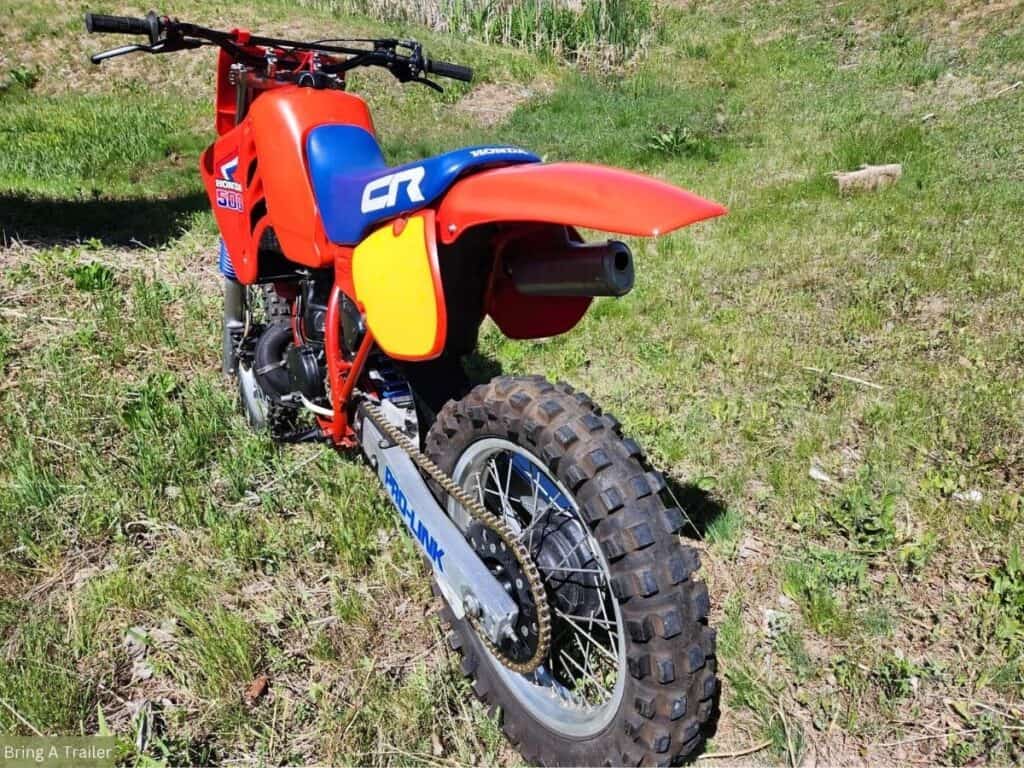
The Honda CR500 was a true icon in the motocross world for over a decade.
However, despite its legendary status, Honda ultimately discontinued the CR500 after the 2001 model year for several reasons.
Environmental Concerns
One of the main reasons for the CR500’s discontinuation was the growing environmental concerns and stricter emission regulations that began to take effect in the late 1990s and early 2000s. Two-stroke engines, like the one found in the CR500, are known for their high emissions output and less efficient fuel consumption compared to four-stroke engines.
As governments began to implement more stringent emissions standards, manufacturers had to adapt their lineups to comply with these new regulations.
In response to these changing environmental policies, Honda and other motorcycle manufacturers began to shift their focus towards developing more environmentally friendly four-stroke engines.
Rider Preference
Another factor that contributed to the CR500’s discontinuation was the changing preferences of motocross riders. As four-stroke motorcycles became more competitive on the racetrack, many riders began to favor the more user-friendly power delivery and overall performance of these machines.
As four-stroke engines offered a broader, more tractable powerband, which made them easier to ride and less fatiguing throughout a race.
In addition, the increasing popularity of Supercross racing, which often took place in smaller, more technical stadium tracks, favored the more manageable power characteristics of four-stroke bikes.
Consumer Preferences
Honda’s decision to discontinue the CR500 was also influenced by market trends and sales.
As consumer preferences shifted towards four-stroke motorcycles, sales of two-stroke models like the CR500 began to decline.
Faced with the increasing costs of developing and producing two-stroke engines, along with the diminishing demand for these models, Honda determined that it was no longer economically viable to continue manufacturing the CR500.
Development of Newer Models
Finally, the discontinuation of the CR500 allowed Honda to focus its resources on developing and refining its four-stroke motocross lineup.
By channeling its efforts into models like the CRF450R and CRF250R, Honda was able to remain competitive in the evolving motocross landscape and cater to the changing needs and wants of riders.
How Fast Does a Honda CR500 2-stroke Go?
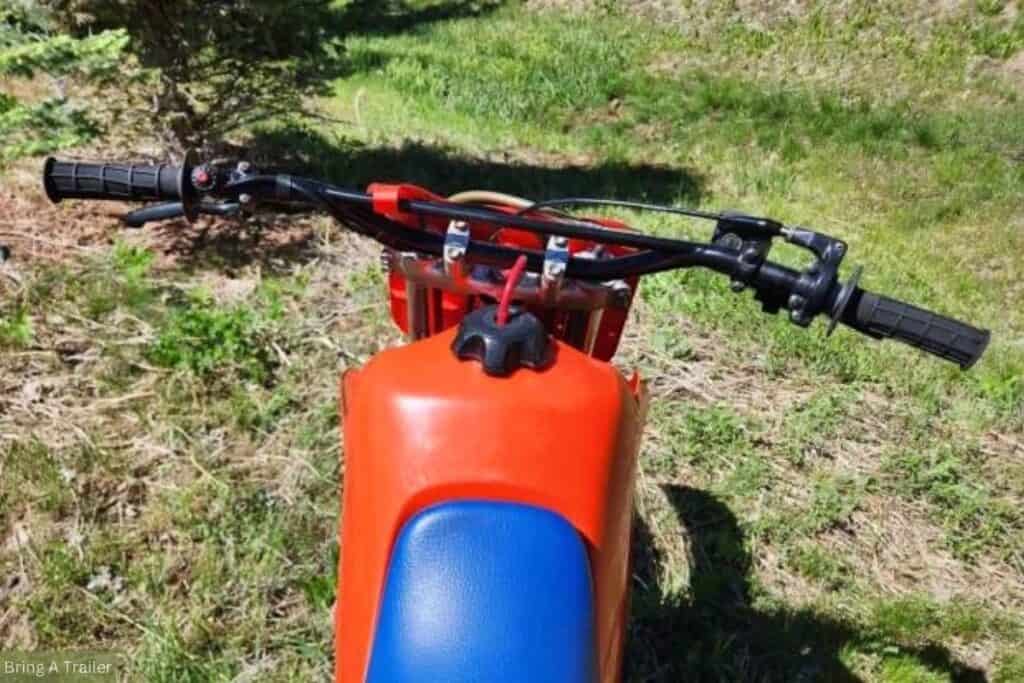
The Honda CR500 was known for its blistering speed and raw power, thanks to its potent 491cc two-stroke engine.
While the top speed of a CR500 could vary depending on factors like gearing, rider weight, and track conditions, these machines were capable of reaching impressive speeds, even by today’s standards.
In terms of top speed, a stock Honda CR500 could reach speeds of around 90 to 100 miles per hour (145 to 160 kilometers per hour) under ideal conditions.
This top speed was achieved through a combination of the bike’s high-output engine, close-ratio transmission, and lightweight design.
It’s important to note, however, that the CR500’s primary focus was not necessarily on achieving the highest possible top speed, but rather on delivering explosive acceleration and power delivery across the rev range.
As the bike’s two-stroke engine was renowned for its blistering acceleration, which allowed riders to consistently win the holeshot during a race.
What was Faster CR500 or KX500?
The Honda CR500 and the Kawasaki KX500 were two of the most popular and powerful two-stroke dirt bikes back in the day, thanks to their incredible performance and raw power.
However, when it comes to top speed, the Honda CR500 has the Kawasaki KX500 beat, as a stock CR500 can reach top speeds of over 90 miles per hour, while a stock KX500 tops out at about 85 miles per hour.
Honda CR500 Top Speed Runs
Additional Dirt Bike Resources:
- The 10 Best 2-Stroke Dirt Bikes that Money Can Buy!
- Are Dirt Bikes Air Cooled? (Everything You Need to Know)
- What is a Good CC for a Dirt Bike? (All Rider Levels Explained)
Recent Posts
In recent years, off-road enthusiasts have been taking their adventures to the next level by installing UTV underglow lights on their side-by-sides. Which adds a unique visual appeal and improves...
Side by sides, also known as UTVs, are used by a wide range of outdoor enthusiasts from off-roaders to farmers to ranchers, and hunters. As these versatile machines offer a unique blend of...

